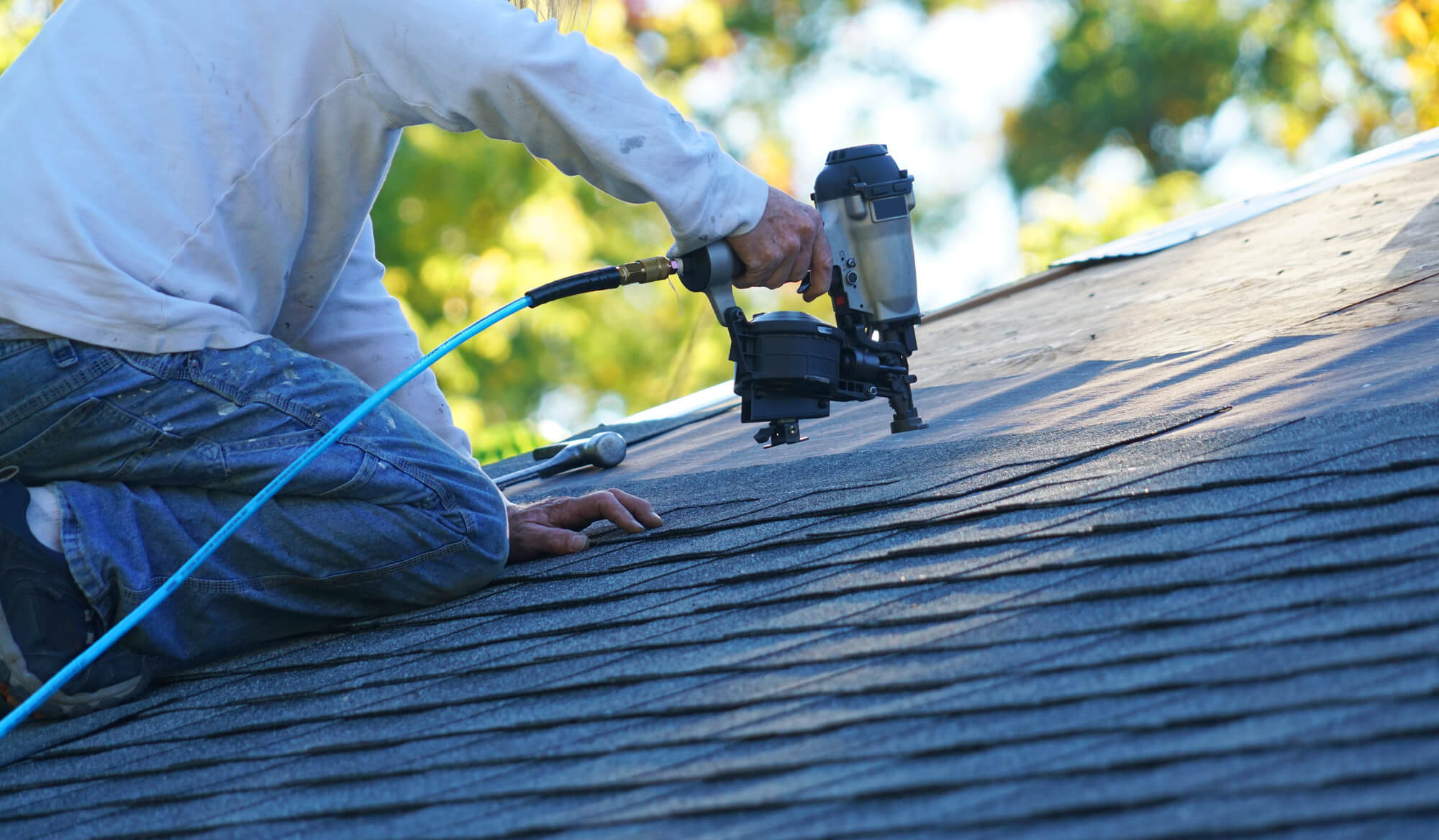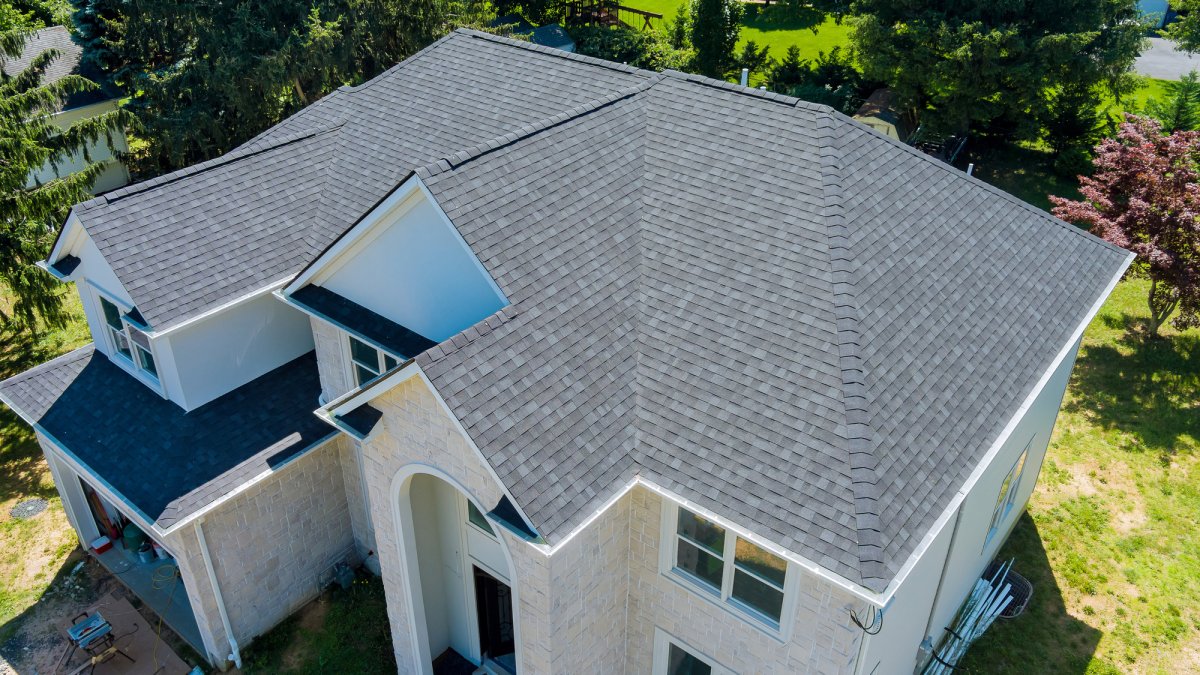
Choosing the right roofing material is not just a design decision; it’s a critical investment. The material you select influences durability, energy efficiency, and overall home value. The aim of this article is straightforward but crucial: to provide an in-depth analysis of the advantages and disadvantages of different shingle roof materials. With this knowledge, you can make an informed decision that best suits your home’s needs.
Asphalt Shingles
Asphalt shingles are one of the most commonly used materials for shingle roofs. Recognized for their versatility, asphalt shingles are a go-to option for many homeowners.
Pros
- Cost-Effective: One of the most attractive features of asphalt shingles is their cost-effectiveness. When compared to other materials, asphalt offers an affordable yet durable roofing solution.
- Easy To Install: Another advantage is the ease of installation. Many contractors have experience with asphalt shingle roofs, making it a relatively quick process. This is especially beneficial for those in time-sensitive climates where weather can be unpredictable.
Cons
- Shorter Lifespan: While asphalt shingles are cost-effective, they tend to have a shorter lifespan. The material deteriorates more rapidly than some alternatives, necessitating more frequent replacements.
- Less Environmentally Friendly: It’s also worth mentioning that asphalt shingles are less eco-friendly. The manufacturing process and the material itself can have a larger carbon footprint than other roofing options.
Asphalt shingles offer an economical and easily accessible roofing solution, making them a popular choice for shingle roofs Wisconsin homeowners often select. However, the trade-off comes in the form of a shorter lifespan and less favorable environmental impact.
Wooden Shingles
When it comes to roofing materials that blend both form and function, wooden shingles often come to mind. These shingles imbue homes with a classic, rustic elegance that’s difficult to replicate with other materials.
Pros
- Aesthetic Appeal: One of the standout features of wooden shingles is their undeniable visual charm. Whether it’s a cottage in the countryside or a modern suburban home, these shingles add a layer of aesthetic sophistication that elevates the property’s curb appeal.
- Natural Insulation: Beyond their beauty, wooden shingles offer natural insulation properties. They excel in retaining warmth during the winter and keeping your home cool in the summer. This makes them not only attractive but also energy-efficient.
Cons
- Fire Risk: While wooden shingles have much to offer, they come with some drawbacks. A significant downside is their vulnerability to fire. Unlike materials like slate or metal, wood poses a higher fire risk, which could be a crucial factor for some homeowners.
- Maintenance Requirements: Wooden shingles require consistent upkeep to maintain their appearance and durability. From treating them to prevent mold and mildew to resealing them periodically, the maintenance needs can be both time-consuming and costly over the long term.
When choosing wooden shingles, it’s essential to balance the allure of their natural beauty and insulation benefits against potential challenges such as fire risk and upkeep.
Metal Shingles
Long lauded for their longevity and robustness, these shingles present an intriguing option for homeowners keen on making a long-term investment in their property’s well-being.
Pros
- Durability: Arguably, the most compelling feature of metal shingles is their impressive lifespan. Unlike asphalt or wooden options, metal shingles can last upwards of 50 years with proper maintenance. They are resilient against most weather conditions, from blistering heat to freezing cold, and can resist rust as well as corrosion.
- Energy Efficiency: Another feather in the cap for metal shingles is their inherent energy efficiency. Metal reflects sunlight, thereby reducing heat absorption. The result is a cooler home in the summer months, which translates to less reliance on air conditioning and ultimately, lower energy bills.
Cons
- High Initial Cost: While the long-term gains are clear, metal shingles require a substantial upfront investment. The material itself, coupled with specialized installation, can put a significant dent in your home improvement budget.
- Noise During Rain: An often overlooked yet notable downside is the level of noise metal roofs can generate during a rainstorm. Some find the sound romantic, while others might deem it a disturbance. Soundproofing can help, but that’s an additional expense to consider.
Metal shingles may be an ideal fit for those looking for a robust and energy-efficient roofing solution. Nevertheless, the upfront costs and potential noise concerns are factors worth considering, especially for those sensitive to sound or working within a budget.
Slate Shingles
Slate shingles exude an air of timeless elegance and undeniable durability. Harvested from natural stone, these shingles offer a unique blend of beauty and functionality that is hard to match.

Pros
- Long Lifespan: Slate’s exceptional durability is one of its crowning achievements. While other materials may require replacement in a few decades, slate can boast a lifespan that stretches to a century or more, making it an investment that can transcend generations.
- Fire-Resistant: Another standout quality is slate’s remarkable resistance to fire. Unlike wood or asphalt, slate is virtually fireproof, offering homeowners additional peace of mind, particularly in regions prone to wildfires or electrical storms.
Cons
- Heavy Weight: One of the caveats of opting for slate shingles is their considerable weight. The sheer density of the material may necessitate structural reinforcement for some homes, adding complexity and cost to the installation process.
- Expert Installation Needed: Installing slate is not a DIY venture; it requires the touch of a skilled artisan. Incorrect installation can not only diminish the aesthetic value but also compromise the roof’s structural integrity, potentially resulting in leaks or worse.
As you weigh your roofing options, consider the labor-intensive nature and weight implications of slate shingles, alongside their enviable lifespan and fire-resistant properties.
Tile Shingles
Among the more opulent roofing materials, tile shingles stand out as a testament to both grandeur and durability. Crafted predominantly from ceramic or concrete, these shingles elevate the aesthetic of any home while promising robust performance.
Pros
- Extremely Durable: If resilience is at the top of your list, tile shingles won’t disappoint. Often lasting for over 50 years, some high-quality options can even endure for a century or more, providing a nearly unparalleled lifespan in the realm of roofing materials.
- Low Maintenance: Another benefit worth mentioning is the minimal upkeep required. Unlike wood, which may succumb to rot or mildew, or asphalt, which may degrade over time, tile shingles remain relatively unscathed by the elements. Occasional cleaning and inspections are typically sufficient.
Cons
- Heavy Weight: Much like slate, the heft of tile shingles necessitates careful planning. Many homes require structural fortifications to support the added weight, translating to an uptick in installation costs and complexity.
- High Cost: Not surprisingly, the long-lasting and low-maintenance nature of tile shingles comes at a price. The material cost, combined with specialized installation, can result in a significant financial commitment upfront.
If you’re willing to make a substantial initial investment for long-term benefits, tile shingles may align well with your home improvement objectives.
Factors To Consider
As you sift through the myriad roofing options available, it’s crucial to weigh several factors that go beyond the material itself.
-
Climate
The regional climate where you reside will inevitably play a pivotal role in your roofing material selection. For instance, metal shingles are superb for reflecting heat, making them ideal for hot, sunny climates. Conversely, wooden shingles offer excellent insulation, serving as an excellent choice for colder, wintry areas.
-
Cost
Budgetary considerations are always paramount when undertaking a significant home improvement project. Asphalt shingles provide a budget-friendly alternative but come with a shorter lifespan. On the flip side, materials like slate and tile require a larger initial investment but offer the perk of longevity, potentially saving you money in the long run.
-
Aesthetics
Your roof is a focal point that contributes to your home’s overall aesthetic appeal. Whether you’re drawn to the rustic allure of wooden shingles or the sleek, modern look of metal, your personal taste is crucial. It will guide you toward a material that complements your home’s architectural style.
Balancing these elements will help you make a choice that satisfies both your practical needs and stylistic desires.
Conclusion
In the quest for the ideal roofing material, homeowners are presented with a vast array of options, each carrying its unique blend of advantages and limitations. What remains constant, however, is the need for a personalized approach to this significant home improvement decision.
In closing, the journey to a new roof is one that demands careful consideration and thorough research. It’s an investment that not only protects your home but also defines its visual character.
Steven Bennett
Related posts
Stay connected
Today's pick
- Things to Remember While Designing Your Custom Modular Kitchen in GurgaonGurgaon now known as Gurugram is the second largest city in the state of Haryana and is a reflectiossn of an ideal modern city with futuristic goals. Witnessing rapid urbanization, it has also emerged as a hub for contemporary homes, with homeowners seeking innovative and... The post Things to Remember While Designing Your Custom Modular […]

